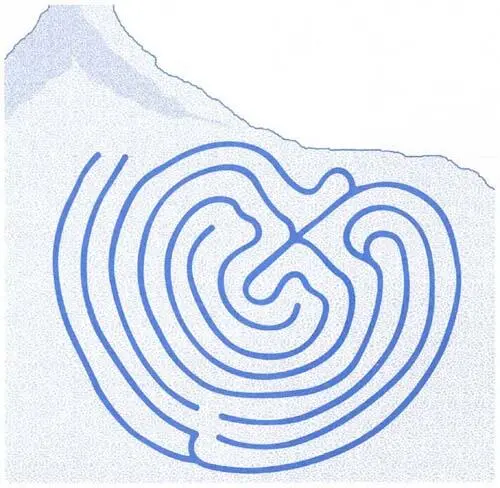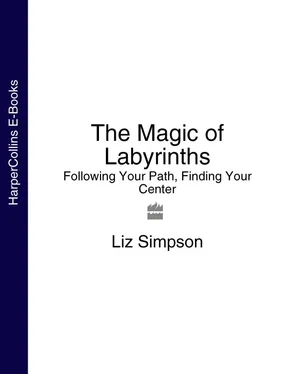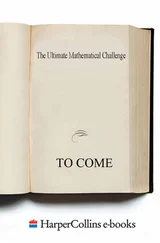In the same way that the Holy Roman Church appropriated existing pagan archetypes and festivals, it built its places of worship on sites which ancient peoples had long revered for their sacred energy. Many churches in England were built on “ley lines” (the phenomenon of electromagnetic energy sometimes called Earth “chi”) because the only way the Catholic church could integrate non-Christians into their own religion was to appropriate the sacred sites at which they already worshipped.
The labyrinth is a wonderful tool that engages people easily and that can be used to address deeper issues around spirituality and the best way to journey through life. So, instead of throwing the baby out with the bathwater, the Christian Church appropriated it for its own needs. The Christian church could not change people’s long-held faith, so they simply Christianized it. In the process, to set theirs apart from pagan examples, church labyrinths became more intricate in their design and ornate in their execution. They also became associated with Biblical cities, such as Jerusalem and Jericho – the latter possibly deriving from the Roman view of labyrinths as a kind of fortified city.
Aside from all the wonderful examples of labyrinths springing up around the world today – many of which we will read about in later chapters – this ancient symbol is proliferating on that most modern of tools – the Internet. If you are interested in the use of the labyrinth as a device in on-line and other interactive games, the World Wide Web will lead you, labyrinth-like, to the key resources.
One particularly inspiring use of the labyrinth on the computer is the on-line Lenten labyrinth. Professor Paula Lemmon teaches beginner’s Latin classes at the Southwestern Methodist University in Dallas, Texas. For the last two years (at the time of writing), her department has created an on-line Lenten labyrinth for which the students are charged with providing translations (from Latin into English) of various classical and religious texts. The 2001 project is totally interactive, with twelve candles pointing the way through this ancient devotional tool in order to illuminate the images and words contained within. Traditionally linked to the concept of pilgrimage by the Christian church ( see here), the Lenten labyrinth allows the Web pilgrim to scroll through the Chartres design to read excerpts from medieval Latin texts (including Ovid’s Fasti), accompanied by images of the Holy Land that were created by the nineteenth-century painter, David Roberts in 1842. These images come from the archives of the University’s Bridwell Library, which holds a world-renowned collection of classical theological and other texts. This is the first time that images from David Roberts’ Holy Land folio have been digitally distributed, and presents a rare opportunity to see his work ( see Resources).
Chapter 2 LABYRINTHINE PATTERNS
“…everything an Indian does is in a circle, and that is
because the Power of the World always works in circles,
and everything tries to be round…”
BLACK ELK, OGLALA LAKOTA, 1930
THE DEVELOPMENT OF THE LABYRINTH PATTERN
It may seem odd that if someone wanted to come up with a simple design symbolizing our journey through life, they did not just draw a straight line from A (birth) to (death). But then, is life ever that straightforward? The labyrinth motif has maintained its appeal because it speaks to the reality of having to navigate many twists and turns as we journey towards our goals.

The meander or “Greek Key” pattern is thought to be the basis of the Classical seven-circuit labyrinth design.
However, while all labyrinths follow a general design comprising of a unicursal path, there are many variations on that theme, and it is these designs that we focus on in this chapter.
The Classical, Seven-circuit Pattern
The oldest labyrinth pattern is that of the Cretan labyrinth, so-named because of its association with that island civilization and religion. It comprises, typically, of seven concentric circuits, although this form exists from three circuits up to nineteen. The oldest British example to which a date can be ascribed is that of a carving on granite named the Hollywood Stone, now on display in the Museum of Antiquities in Dublin. The stone and its seven-circuit Cretan design was found on a pilgrim’s track that wove its way through the Wicklow Mountains in Ireland from Hollywood to the Celtic monastic settlement at Glendalough.
When playing around with the labyrinth design, Jeff Saward the British editor of the labyrinth journal Caerdroia (see story here, and Resources), together with a friend, worked out that the Classical seven-circuit labyrinth was simply a variation on a theme commonly depicted on Greek and Roman pottery – the meander. This meander pattern or “Greek key” was common to Old Europe many thousands of years before the Greek civilization flourished and indeed examples have been discovered on “Bird Goddess” figurines at Mezin in the Ukraine that date back to c. 18000–15000B.C.

The Hollywood Stone, found on a pilgrim’s way in the Wicklow Mountains, Ireland.
While not resembling a labyrinth at first glance, when you twist this unbroken design into a circle it does indeed become labyrinth-like. The similarity is even more apparent when you look at the Man in the Maze motif of the Hopi tribe of Arizona, where the corners of that labyrinth are squared-off rather than curved. One modern example of this design – having the wider entrance and squared-off rather than curved corners – can be found outside the Museum of International Folk Art in Santa Fe, New Mexico ( see story, here).
Interest in the meander design has been maintained over the centuries and, given the vast number of products available on the Internet that incorporate it, particularly jewelry and home furnishings, the interest continues unabated. One interior design company specializing in the Greek key design claims that introducing this pattern into the home helps achieve a sense of a bigger, warmer, softer, calmer, friendlier environment. Is this just marketing rhetoric or is there something special about the energy created by the meander pattern, as is claimed for the labyrinth? Certainly, earlier civilizations, such as that of the Greeks, stressed the importance of design for achieving harmonious living. They called this approach “sacred geometry” ( see here).
The Man in the Maze motif from the Hopi tribe, Arizona. The squared-off corners are reminiscent of the “Greek Key” design.
Although it is the most common form, the classical Cretan labyrinth pattern does not have to comprise of seven circuits. One of the most unusual three-circuit labyrinths is featured high in the Peruvian Andes where ancient artists created gigantic geometric forms and animal outlines that are discernible only by air. These are the Nazca lines, named after the culture that flourished in the region during the sixth or seventh centuries. Thought variously to be the landing strips for alien spacecraft or to have astronomical/astrological importance, the Nazca images were formed by scraping away the top layer of the pampa to expose the chalky white gypsum underneath. These strange labyrinthine-like totems include that of the curling tail of a Monkey and the winding pathway formed by the outline of a Spider.
Читать дальше














